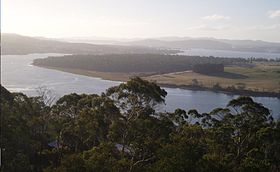
Launceston or is a city in the north of Tasmania, Australia, at the confluence of the North Esk and South Esk rivers where they become the Tamar River (kanamaluka). As of 2021, Launceston has a population of 87,645. Launceston is the second most populous city in Tasmania after the state capital, Hobart. As of 2020, Launceston is the 18th largest city in Australia. Launceston is fourth-largest inland city and the ninth-largest non-capital city in Australia. Launceston is regarded as the most liveable regional city, and was one of the most popular regional cities to move to in Australia from 2020 to 2021. Launceston was named Australian Town of the Year in 2022.

George Town is a large town in north-east Tasmania, on the eastern bank of the mouth of the Tamar River. The Australian Bureau of Statistics records the George Town Municipal Area had a population of 6,764 as of 30 June 2016.

Low Head is a rural residential locality in the local government area (LGA) of George Town in the Launceston LGA region of Tasmania. The locality is about 5 kilometres (3.1 mi) north of the town of George Town. The 2016 census recorded a population of 572 for the state suburb of Low Head. It is a suburb of George Town, on a peninsula at the mouth of the Tamar River.
Newnham is a residential locality in the local government area (LGA) of Launceston in the Launceston LGA region of Tasmania. The locality is about 7 kilometres (4.3 mi) north of the town of Launceston. The 2016 census recorded a population of 6453 for the state suburb of Newnham. It is a suburb of Launceston. Newnham is located on the East Tamar Highway, on the eastern side of the Tamar River.
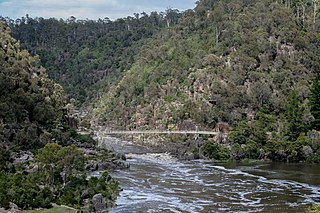
The South Esk River, the longest river in Tasmania, is a major perennial river located in the northern region of Tasmania, Australia.

The North Esk River is a major perennial river located in the northern region of Tasmania, Australia.
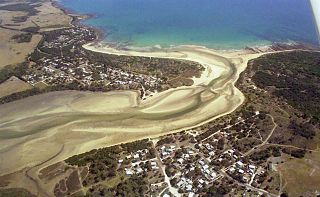
Bellingham is a rural locality in the local government area (LGA) of George Town in the Launceston LGA region of Tasmania. The locality is about 39 kilometres (24 mi) north-east of the town of George Town. The 2016 census has a population of 60 for the state suburb of Bellingham. It is a tiny coastal hamlet in northern Tasmania, situated on the mouth of the Pipers River directly opposite the town of Weymouth. The town is located 62 kilometres (39 mi) from Launceston, 20 kilometres (12 mi) from Bridport and 38 kilometres (24 mi) from George Town.
Blackwall is a rural locality in the local government area (LGA) of West Tamar in the Launceston LGA region of Tasmania, Australia. The locality is about 21 kilometres (13 mi) south-east of the town of Beaconsfield. The 2016 census has a population of 270 for the state suburb of Blackwall. It is a small town located near Gravelly Beach on the western side of the Tamar River, north of Launceston.

The Trevallyn Power Station is a run-of-the-river hydroelectric power station located in the northern Midlands region of Tasmania, Australia. The power station is situated on the Great Lake and South Esk catchment and is owned and operated by Hydro Tasmania.

Trevallyn is a residential locality in the local government areas (LGAs) of Launceston (25%) and West Tamar (75%) in the Launceston LGA region of Tasmania. The locality is about 3 kilometres (1.9 mi) west of the town of Launceston. The 2016 census recorded a population of 4562 for the state suburb of Trevallyn. It is a suburb of Launceston.
Invermay is a residential locality in the local government area (LGA) of Launceston in the Launceston LGA region of Tasmania. The locality is about 3 kilometres (1.9 mi) north of the town of Launceston. The 2021 census recorded a population of 3,498 for the state suburb of Invermay. It is a suburb of Launceston, which contains the minor suburb of Inveresk, it is located on the eastern side of the Tamar River and the northern side of the North Esk River, the suburb is most notable as being home to York Park.
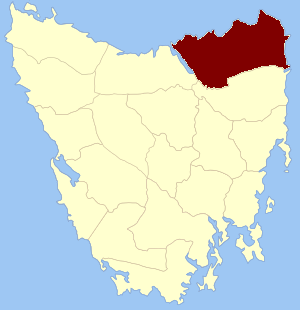
Dorset Land District is one of the twenty land districts of Tasmania which are part of the Cadastral divisions of Tasmania. It was formerly one of the 18 counties of Tasmania. It is located at the north-eastern tip of Tasmania. It is bordered by the Tamar River to the west, the George River to the south-east, and the North Esk River to the south. It includes Bridport, George Town and Scottsdale. It also includes some northern suburbs of Launceston. The local government area of the Dorset Council is in a similar region. It is named after the county of Dorset in England, and towns in the area were named after towns in that county.
The Launceston to Hobart yacht race is a 285 nautical mile race, commencing at Beauty Point on the Tamar River, with competitors sailing out of the Tamar River, east along the northern coast of Tasmania, through Banks Strait and south down Tasmania's East Coast, through Mercury Passage between mainland Tasmania and Maria Island, across Storm Bay, to a finish line in the Derwent River. The race departs on 27 December each year. The race is known as the L2H race despite the race commencing at Beauty Point, some 45 kilometers north of Launceston.

Riverside is a rural and urban locality in the local government areas of Meander Valley and West Tamar in the Launceston region of Tasmania. The locality is about 39 kilometres (24 mi) south-east of the town of Beaconsfield. The 2016 census has a population of 6472 for the state suburb of Riverside. It is a residential suburb 5 kilometres (2.5 mi) north-west of the central business district of Launceston, Tasmania's second largest city. The West Tamar Highway runs through the suburb, adjoining Riverside to the West Tamar, which includes small towns: Beaconsfield, and Beauty Point. Riverside is part of the West Tamar Council local government area. The suburb is now Launceston's largest by population, narrowly ahead of Kings Meadows. The main shopping centre opened in the 1960s and includes: a Woolworths supermarket, a Banjos bakery, a pharmacist and several retail shops.
Beechford is a rural locality in the local government area (LGA) of George Town in the Launceston LGA region of Tasmania. The locality is about 22 kilometres (14 mi) north-east of the town of George Town. The 2016 census has a population of 90 for the state suburb of Beechford. It is a small beach side village on the northern coast of Tasmania, 48.0 kilometres (29.8 mi) north of Launceston. Beechford is also the place where the Curries River joins up with the Tasman Sea in Bass Strait. The village is surrounded by farmland, and land administered by Crown Lands, the Department of Defence, and Parks and Wildlife, creating a natural corridor of unbroken sea views. This beautiful part of Tasmania, with its warm, relatively dry micro-climate and stunning beach and conservation areas, is still "undiscovered" by tourism, leaving visitors to enjoy the area relatively undisturbed.
Kelso is a rural locality in the local government area (LGA) of West Tamar in the Launceston LGA region of Tasmania. The locality is about 14 kilometres (8.7 mi) north of the town of Beaconsfield. The 2016 census has a population of 146 for the state suburb of Kelso. It is located west of George Town. It was settled in the early 19th century and is located on Kelso Bay, a small bay on the Tamar River. Kelso is known as a fishing resort for flathead, whiting and mullet. Kelso is also located near the Narawntapu National Park.

Low Head Lighthouse is in Low Head, Tasmania, about 7 kilometres (4.3 mi) north of George Town on the east side of the mouth of the Tamar River. It was the third lighthouse to be constructed in Australia, and it is also Australia's oldest continuously used pilot station. This light is now unmanned and automated.
York Town is a rural locality in the local government areas (LGA) of West Tamar and Latrobe in the Launceston and North-west and west LGA regions of Tasmania. The locality is about 7 kilometres (4.3 mi) north-west of the town of Beaconsfield. The 2016 census has a population of 72 for the state suburb of York Town. It was the first attempt to establish a British presence in northern Tasmania, in 1804. It was a "bustling village" until 1808.

The Cam River estuary is located in Somerset roughly halfway between the township of Wynyard and the city of Burnie on the North West Coast of Tasmania. The northern part of the Cam River forms part of the boundary between the City of Burnie and Waratah-Wynyard local government areas.
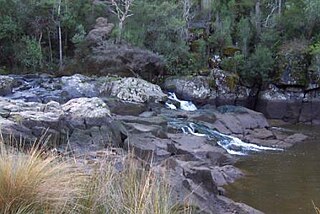
The Supply River is a perennial river located in the northern region of Tasmania, Australia.
